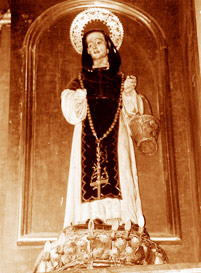Saint John Macias
| Saint John Macias | |
|---|---|
Statue of St. John Macias | |
| Laybrother, Porter | |
| Born | 2 March 1585 in Ribera del Fresno, Extremadura, Spain |
| Died | 16 September 1645 in San Luis District, Lima, Peru |
| Venerated in | Roman Catholicism |
| Beatified | 1837
by Pope Pius VII |
| Canonized | 1975
by Pope Paul VI |
| Major shrine | Our Lady of the Rosary of Lima Church |
| Feast | 18 September |
Saint John Macías, (Spanish San Juan Macias alt. sp Massias) (born 2 March 1585 Ribera del Fresno, Extremadura, Spain; died September 16, 1645, Lima, Peru), was a Spanish Dominican religious laybrother and Catholic saint who evangelized in Peru in 1620. He was canonized in by 1975 by Pope Paul VI. His main image is located at the main altar of the church of Our Lady of the Rosary of Lima and is venerated by the local laity in Peru. A temple was built in his honor in 1970 in San Luis, Lima, Peru.
Biography
Saint John Macías was born Juan de Arcas Sanchez on 2 March 1585 in Ribera del Fresno, Extremadura which was under the jurisdiction of the Palencia dicocese to Pedro de Arcas y Juana Sánchez. It is not known why he changed his name. Orphaned at the age of four, he was reared by an uncle who trained him as a shepherd.
At the age of 25, he then started working with a wealthy businessman who offered him an opportunity to travel to South America. He first arrived at Cartagena de Indias Colombia and then at Reino de Nueva Granada stopping by Pasto and then Quito, Ecuador, in order to ultimately arrive at Perú where he would remain for the rest of his life. His first course of action there in Lima was to observe the Order of Preachers, indicating an active interest in joining in order to serve God. This was an in line with a vision he had 20 years ago commanding him to travel to Peru.
Confident in his abilities and talents as a sheepherder, he worked with shepherds in the outskirts of the city and it was there where he began his life as a religious. His sense of piety eventually led him to part with all of his belongings and giving it all to the poor, did a lot of community service and supported the Dominicans where he approached the Dominican friary of Santa María Magdalena where he was admitted as a cooperator brother on 23 January 1622 finally accepting the Dominican habit. One year later on 25 January 1623 he took his final vows.
Counsel to the rich and poor
At the friary, Saint John Macías's life was filled with fervent prayer, frequent penance and charity. As a result of his austerity, he quickly fell ill and had to have a risky surgery. Nevertheless, he continued to care for other sick and needy as they waited at the friary gates. Beggars, disabled people and other disadvantaged people where commonplace throughout Lima where they flocked to him at the friary gates for counsel and comfort. The wealthy upper classes where no strangers to St. John Macias; they also sought his counsel at the gates.
St. John Macias, however, expressed a greater desire to spend more time in contemplative solitude rather than engage in conversational activities with others. He confessed this to Father Abbot Ramírez who said, “If he were to never follow his vow of obedience, nobody would have ever seen his face." But his official position as the friary's porter, which he held for over 20 years and went against his natural inclinations of solitude, served to continue disciplining his vow of obedience. This filled him with a joyful sense of fulfillment. He died of natural causes in 1645.
Veneration
The remains of Saint John Macias are transferred annually every 21 September from the Peruvian sanctuary of Santo Domingo to the church of his same name in San Luis, Lima. An annual public procession also takes place in Peru every third Sunday of November in Lima. His image, along with that of the more famous Saint Martin of Porres (his friend and contemporary) are paraded around the streets and venerated by the faithful of Peru.
Several miracles were attributed to him during his life and after his death which led to his ultimate canonization. He was beatified in 1837 by Pope Pius VII and canonized in 1975 by Pope Paul VI
His feast day is on September 18.
External links
Credits
New World Encyclopedia writers and editors rewrote and completed the Wikipedia article in accordance with New World Encyclopedia standards. This article abides by terms of the Creative Commons CC-by-sa 3.0 License (CC-by-sa), which may be used and disseminated with proper attribution. Credit is due under the terms of this license that can reference both the New World Encyclopedia contributors and the selfless volunteer contributors of the Wikimedia Foundation. To cite this article click here for a list of acceptable citing formats.The history of earlier contributions by wikipedians is accessible to researchers here:
The history of this article since it was imported to New World Encyclopedia:
Note: Some restrictions may apply to use of individual images which are separately licensed.
